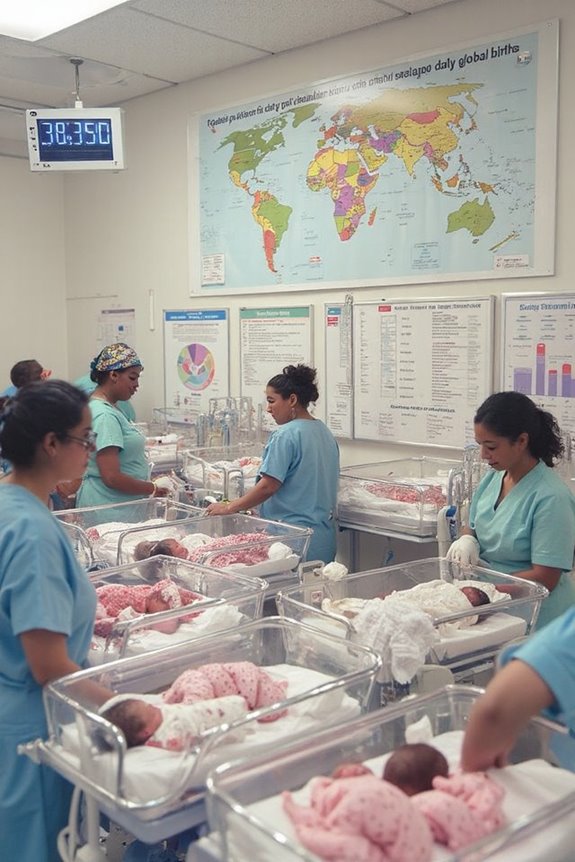Approximately 362,437 babies are born worldwide each day, which breaks down to about 15,102 births every hour or 4.2 births per second. India leads with around 63,171 daily births, followed by China (23,845) and the United States (10,031). Global birth rates are gradually declining, with the 2025 rate projected at 17.13 per 1,000 people—a 0.95% decrease from 2024. The numbers reveal fascinating patterns across regions and cultures.
Key Takeaways
- Approximately 362,437 babies are born daily across the globe.
- Every hour, about 15,102 newborns enter the world.
- The birth rate equals roughly 4.2 births every second worldwide.
- India leads with 63,171 daily births, followed by China (23,845) and the U.S. (10,031).
- Global birth rates are declining, with a projected 0.95% decrease from 2024 to 2025.
Global Birth Statistics: The Numbers at a Glance
Every single day, an astounding 362,437 babies enter our world. That translates to about 15,102 newborns every hour and 4.2 births every second. When you consider these figures, the sheer magnitude of global fertility becomes apparent.
Birth frequency worldwide follows measurable patterns, with the current global birth rate at 17.13 per 1,000 people in 2025. This represents a 0.95% decline from 2024, continuing a long-term downward trend in fertility rates.
- Global birth rate: 17.13 per 1,000 people (2025)
- Yearly decline: 0.95% from previous year
- Historical context: Significant decrease from 36.9 per 1,000 in 1950-1955
These statistics help experts track population growth and plan for future resource needs.
Birth Rates Across Different Countries
Dramatic differences exist in birth rates around the world, with some nations welcoming over eight times more newborns per capita than others. In my analysis of global birth rate comparisons, I’ve found that Niger leads with 44.5 births per 1,000 people, while Vatican City records just 4.63.
These fertility trends follow clear regional patterns:
- Sub-Saharan African nations dominate high birth rate statistics
- Central Africa consistently shows the fastest population growth
- Only Afghanistan and Yemen represent non-African countries in the top 20
Several factors drive these differences:
- Economic development level
- Healthcare accessibility
- Female education rates
- Political stability
The demographic shift model explains this phenomenon: as countries develop and infant mortality decreases, birth rates typically fall—a pattern we’re seeing play out across different regions at varying paces.
Regional Variations in Birth Patterns

While global birth rates share common influencing factors, regional variations reveal striking patterns that I’ve observed across different parts of the world. These differences stem from multiple sources:
- Healthcare access creates significant regional disparities in maternal health outcomes
- Cultural influences shape family size preferences and birth timing
- Economic stability affects how many children families choose to have
- Family planning availability varies dramatically between regions
The urban-rural divide is particularly notable, with rural areas typically maintaining higher birth rates. Demographic trends show that regions with higher female education levels generally experience lower fertility rates. I’ve found that areas with robust healthcare systems and supportive family policies tend to have better birth outcomes, even when birth rates are lower.
Historical Trends and Future Projections

Throughout recent decades, I’ve observed significant shifts in global birth patterns that tell a compelling story about human development. The historical patterns reveal a steady decline in birth rates worldwide, with approximately 362,437 babies born daily in 2025.
This trend reflects the demographic change occurring globally:
- India leads with 63,171 births per day
- China follows with 23,845 daily births
- The U.S. records about 10,031 births daily
Future forecasts suggest population growth will continue but at a decreasing rate of around 0.85% annually. This slowdown stems primarily from falling fertility rates, particularly in developing regions undergoing economic advancement.
The long-term implications include aging populations in countries with below-replacement fertility rates, creating workforce challenges and reshaping social structures worldwide.
Factors Influencing Modern Birth Rates
The drivers behind today’s birth rates extend far beyond simple population dynamics, creating a complex web of influences that shape our demographic future. I’ve found that socioeconomic factors play an essential role in family planning decisions.
Several key elements affect modern birth rates:
- Economic stability and job security greatly impact family planning choices
- Higher female education and workforce participation correlate with lower fertility rates
- Immigration effects help offset declining birth rates in many developed nations
- Access to fertility technologies like IVF has expanded reproductive options
- Regional variations persist, with Africa maintaining higher rates due to cultural factors and lower contraceptive use
The interplay between technology, policy support (such as paid family leave), and healthcare access continues to reshape birth patterns worldwide, with fertility rates generally decreasing as income and education levels rise.
The Economic Impact of Changing Birth Rates
As birth rates continue to shift globally, I’ve observed profound economic consequences that ripple through national economies and household finances alike. With approximately 362,437 babies born daily worldwide in 2025, these demographic changes directly affect economic sustainability.
The implications are substantial:
- Aging populations increase dependency ratios, straining social security systems
- Labor market dynamics shift as workforce populations shrink
- Healthcare costs redistribute from pediatric to elderly care
- Housing markets adjust to changing household demographics
Countries experiencing the most significant declines may need to implement fiscal policy adjustments, including:
- Tax incentives for families
- Enhanced parental support programs
- Strategic immigration policies
Without intervention, many nations face challenging workforce shortages and productivity concerns. The relationship between birth rates and economic stability has never been more evident than in our current global landscape.
Urbanization and Education: Key Drivers of Birth Rate Changes
While examining global birth trends, I’ve discovered that urbanization and education stand as the two most influential factors reshaping worldwide fertility patterns. The urban lifestyle typically leads to smaller families due to higher living costs and career priorities that delay childbearing.
Educational impact is equally significant, with studies showing educated populations—especially in urban areas—have better access to family planning resources and contraceptives. This urban education advantage creates meaningful socioeconomic factors that influence reproductive decisions.
Women empowerment through education allows for more informed choices about family size. Resource access in cities further enables these decisions, while cultural shifts occur as urbanized populations increasingly prioritize quality of life over larger families.
These combined forces explain why urban birth rates consistently fall below rural counterparts worldwide.
Cultural and Social Dimensions of Childbirth Worldwide
Childbirth traditions vary dramatically across cultures, reflecting deep-rooted values that shape how societies welcome new life into their communities. These practices aren’t merely ceremonial—they represent essential social frameworks that support new mothers and babies.
In many regions, cultural rituals surrounding birth serve important community functions:
- Creating social bonds between generations
- Transferring traditional knowledge about childcare
- Providing structured community support during the vulnerable postpartum period
The modernization of childbirth practices has introduced tensions between traditional and medical approaches. While global health initiatives aim to reduce maternal mortality, they must balance medical intervention with respect for cultural traditions.
Family structures continue to influence childbirth experiences, with societies that emphasize extended family involvement often providing more robust support networks for new mothers.
Frequently Asked Questions
What Percentage of Daily Births Are Premature or Medically Complicated?
I’d say about 31% of daily births face challenges – 11% are premature births (around 40,000 babies) and another 20% involve medical complications requiring intervention. That’s a significant portion needing special care.
How Does Climate Change Impact Birth Rates Globally?
I’m shocked people still ask this! Climate change disrupts population dynamics through healthcare limitations, food instability, and migration patterns. Climate policies must address these impacts on birth rates, especially in vulnerable regions.
Which Days of the Year Have the Highest Birth Rates?
I’ve found that September, particularly the 9th, has the highest birth rates. August is also popular. These reflect seasonal trends from winter conceptions, while holiday births are typically lower around Christmas and New Year’s.
How Do Refugee Crises Affect Birth Statistics in Receiving Countries?
I’ve found that refugee crises notably alter birth statistics through changing refugee demographics and strained healthcare access. When refugees arrive, initial birth rates may spike, but long-term they typically converge with local patterns.
What Technological Advancements Have Most Influenced Childbirth Survival Rates?
I’d say telemedicine innovations and advanced monitoring equipment have considerably improved childbirth survival rates. They’ve revolutionized prenatal care, especially in remote areas, while antibiotics and improved surgical techniques have significantly reduced maternal mortality worldwide.





